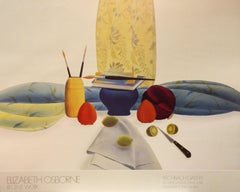Elizabeth Osborne Poster
1980s Still-life Prints
Lithograph
People Also Browsed
1980s Realist Still-life Paintings
Watercolor, Archival Paper
1980s Abstract Expressionist Still-life Paintings
Archival Paper, Charcoal, Casein
Elizabeth Osborne for sale on 1stDibs
Elizabeth Osborne, born in Philadelphia on June 5, 1936, has exhibited extensively throughout the United States for over 40 years. After graduating from the Pennsylvania Academy of the Fine Arts and the University of Pennsylvania in 1959 for her undergraduate studies, Osborne was awarded a Fulbright Scholarship and traveled to Paris to study art. Her work is included in the collections of the Philadelphia Museum of Art, the Pennsylvania Academy of the Fine Arts, the Woodmere Art Museum, The State Museum of Pennsylvania, the Delaware Art Museum and the McNay Art Museum. Her recent solo exhibitions include J. Cacciola Gallery, New York and The Print Center, Philadelphia. Osborne has received numerous awards including the Percy M. Owens Memorial Award, a MacDowell Colony Grant, the Richard and Hinda Rosenthal Foundation Award and a Fulbright Fellowship. Osborne has been an instructor at the Pennsylvania Academy of Fine Arts since 1966. Working primarily in oil paint and watercolor, her paintings are known to bridge ideas about formalist concerns, particularly luminosity with her explorations of nature, atmosphere and vistas. Beginning with figurative paintings in the 1960s and 70s, she moved on to bold, color-drenched landscapes and eventually abstractions that explore color spectrums. She lives and works in Philadelphia.
Finding the Right Still-life-prints-works-on-paper for You
As part of the wall decor in your living room, dining room or elsewhere, original still-life prints and other still-life wall art can look sophisticated alongside your well-curated decorative objects and can help set the mood in a space.
Still-life art, which includes work produced in media such as painting, photography, video and more, is a popular genre in Western art. However, the depiction of still life in color goes back to Ancient Egypt, where paintings on the interior walls of tombs portrayed the objects — such as food — that a person would take into the afterlife. Ancient Greek and Roman mosaics and pottery also often depicted food. Indeed, popular still-life prints often feature food, flowers or man-made objects. By definition, still-life art represents anything that is considered inanimate.
During the Middle Ages, the still life genre was adapted by artists who illustrated religious manuscripts. A common theme of these still-life paintings is the reminder that life is fleeting. This is especially true of vanitas, a kind of still life with roots in the Netherlands during the 17th century, which was built on themes such as death and decay and featured skulls and objects such as rotten fruit. In northern Europe during the 1600s, painters consulted botanical texts to accurately depict the flowers that were the subject of their work.
While early examples were primarily figurative, you can find still lifes that belong to different schools and styles of painting and printmaking, such as Cubism, Impressionism and contemporary art.
Leonardo da Vinci’s penchant for observing phenomena in nature and filling notebooks with drawings and notes helped him improve as an artist of still-life paintings. Vincent van Gogh, an artist who made a couple of the most expensive paintings ever sold, carried out rich experiments with color over the course of painting hundreds of still lifes, and we can argue that Campbell’s Soup Cans (1961–62) by Andy Warhol counts as still-life art.
Still-life art enthusiasts and collectors of Warhol prints have lots of reasons to love the cultural icon — when Warhol brought the image of a Campbell’s soup can out of the supermarket and into the studio, in 1961, he secured his legacy as a radical contemporary artist. After Warhol painted the soup cans, he realized that he could more readily achieve the mass-produced aesthetic he was seeking with silkscreens, also called screen-prints, and he began experimenting with silkscreening on canvas. He used the technique to print paintings of Coke bottles and dollar bills (both in 1962), as well as his treasured Brillo box sculptures (1964).
When shopping for a still-life print, think about how it makes you feel and how the artist chose to represent its subject. When buying any art for your home, choose pieces that you connect with. If you’re shopping online, read the description of the work to learn about the artist and check the price and shipping information. Make sure that the works you choose complement or relate to your overall theme and furniture style. Artwork can either fit into your room’s color scheme or serve as an accent piece. Introduce new textures to a space by choosing an oil still-life painting.
On 1stDibs, the collection of still-life prints and other still-life wall art includes works by Jonas Wood, Alex Katz, Nina Tsoriti and many more.
